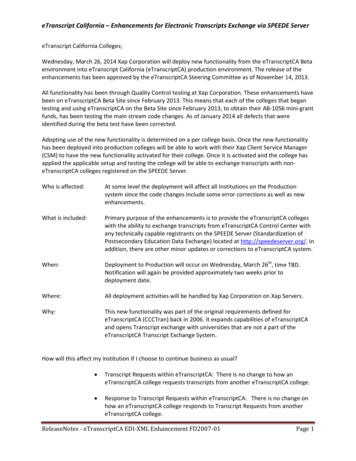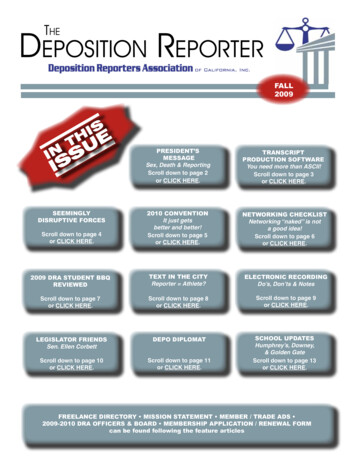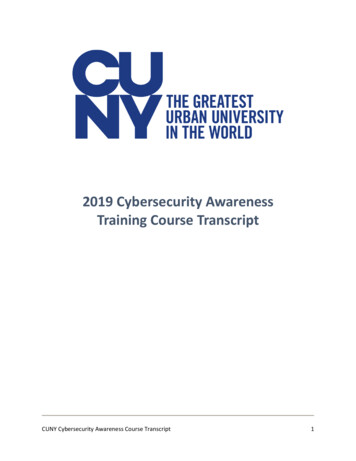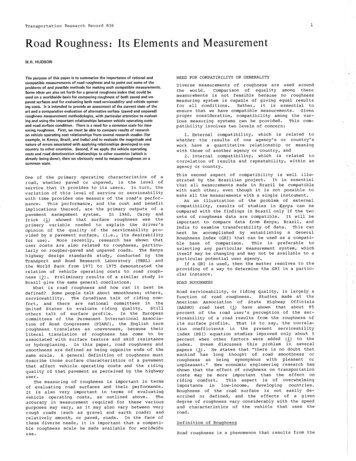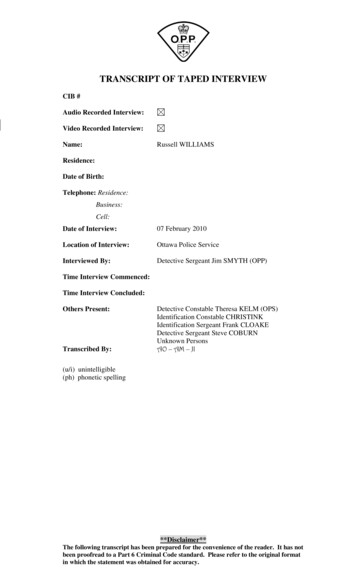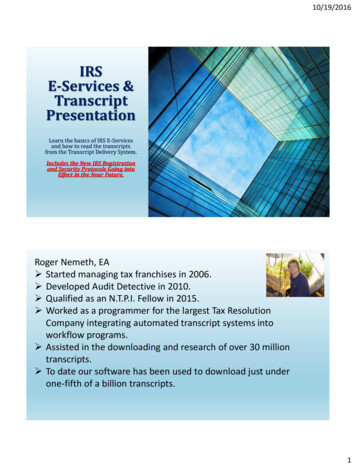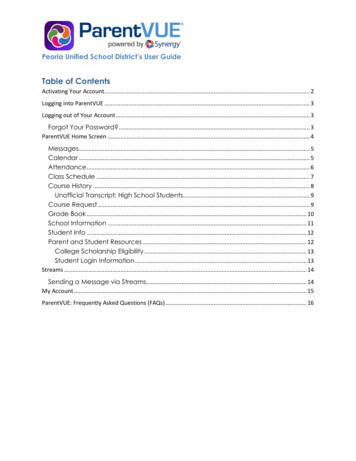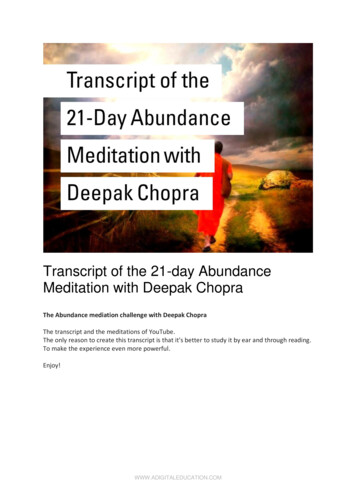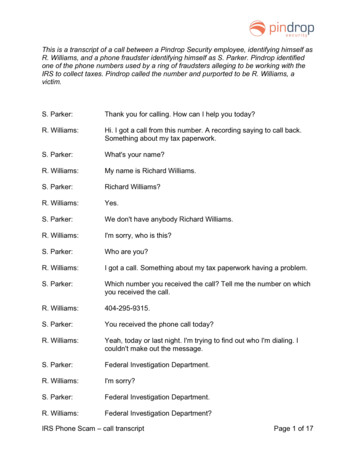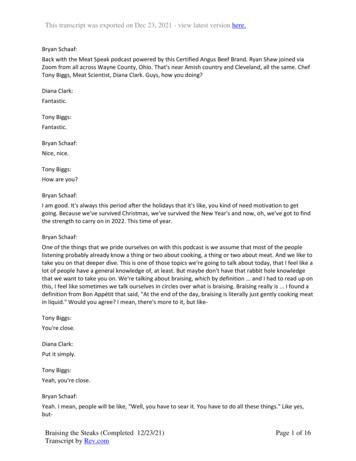
Transcription
This transcript was exported on Dec 23, 2021 - view latest version here.Bryan Schaaf:Back with the Meat Speak podcast powered by this Certified Angus Beef Brand. Ryan Shaw joined viaZoom from all across Wayne County, Ohio. That's near Amish country and Cleveland, all the same. ChefTony Biggs, Meat Scientist, Diana Clark. Guys, how you doing?Diana Clark:Fantastic.Tony Biggs:Fantastic.Bryan Schaaf:Nice, nice.Tony Biggs:How are you?Bryan Schaaf:I am good. It's always this period after the holidays that it's like, you kind of need motivation to getgoing. Because we've survived Christmas, we've survived the New Year's and now, oh, we've got to findthe strength to carry on in 2022. This time of year.Bryan Schaaf:One of the things that we pride ourselves on with this podcast is we assume that most of the peoplelistening probably already know a thing or two about cooking, a thing or two about meat. And we like totake you on that deeper dive. This is one of those topics we're going to talk about today, that I feel like alot of people have a general knowledge of, at least. But maybe don't have that rabbit hole knowledgethat we want to take you on. We're talking about braising, which by definition . and I had to read up onthis, I feel like sometimes we talk ourselves in circles over what is braising. Braising really is . I found adefinition from Bon Appétit that said, "At the end of the day, braising is literally just gently cooking meatin liquid." Would you agree? I mean, there's more to it, but likeTony Biggs:You're close.Diana Clark:Put it simply.Tony Biggs:Yeah, you're close.Bryan Schaaf:Yeah. I mean, people will be like, "Well, you have to sear it. You have to do all these things." Like yes,but-Braising the Steaks (Completed 12/23/21)Transcript by Rev.comPage 1 of 16
This transcript was exported on Dec 23, 2021 - view latest version here.Tony Biggs:You got a career in culinary after that statement, really.Bryan Schaaf:I appreciate that. I'm on the eating end of things. That said, braising is one of those things, I've alwaysthought if you have a piece of meat, and you've watched like chopped, if you watch any of thesequickfire TV shows. If you have a piece of meat in front of you and you don't know what to do with it, Ialways feel like there are like three things you can do with it. You can beat the snot out of it, bread itand fry it. Schnitzel it, if you will. You can smoke it, low and slowDiana Clark:Vicious.Bryan Schaaf:Or you can braise it. And no matter what, you're going to like the outcome. No matter whether it's eyeof round, no matter whether it's bottom round from an ostrich. Like it's going to be pretty good. I mean,let's talk a little bit about braising.Tony Biggs:I have to give all my braising techniques to my mentor, Klaus Friedenreich. Back in my culinary days andhe has credentials. So not only was he an instructor at Cordon Bleu Academy in Orlando, but he was alsocaptain of the 1980 culinary Olympic team for the United States of America that won gold in Frankfurt,Germany that year. So I give him a lot of credit because he always talked about braising. Being German,and growing up and his grandma, he would tell us stories about braising in the war days and thickeningsauces with ginger snap cookies and all that. But he really had the technique down for braising.Tony Biggs:So I'm going to share my little tidbits with you guys and gals out there on our podcast. And I follow fourbasic steps, but really the most important step I found that some chefs fail on is they just want to getthings into a pan real quick and turn the oven up to 400 degrees, cover it with foil and then let it go.Well, that's all well and done. And eventually, yes, it'll be cooked, chefs. It will. But is that what youreally want? Or do you really want to go low and slow on some of these cuts that are very, very tough?Tony Biggs:So for me, the best results is not allowing the braising liquid to actually boil, but to simmer. Simmer onthe lowest setting that you can possibly have between 275 degrees. But I swear, some chefs, they swearon even a lower temperature to 200 degrees. It's kind of like sous vide, if you think about sous vide nowthat's enteredDiana Clark:Mm-hmm (affirmative).Tony Biggs:Braising the Steaks (Completed 12/23/21)Transcript by Rev.comPage 2 of 16
This transcript was exported on Dec 23, 2021 - view latest version here.The culinary world right now. It's the same process without the bag or without the water. So if youfollow those steps, braising is another step of sous vide. It's low and slow and it's kind of what the loveyou put into it.Tony Biggs:So I got four are basic points here. So step one, you have to sear your meat. Ladies and gentlemen, youhave to sear it. You don't throw it in there raw and just hope for the best. You need to sear it on bothsides. And by doing that, we season the meat on all sides. We season, salt and pepper, whatever. Put oilinto a heavy, very hot pot, like a Dutch oven, excuse me, or Le Creuset. Set it on medium heat and thenadd the meat. Do not crowd the pot. Very important step. Do not crowd the pot. It's not a rock concert,where you're getting tons of people in there. Let them meat breathe. I always tell people, let it breathe,keep it far apart. It's not a rock concert. Just don't stuff everything in there and let it go because it'sgoing to turn into like boiled meat.Bryan Schaaf:It's meat social distancing. Yeah.Tony Biggs:It's meat social . I love that.Diana Clark:I like it. I like that.Tony Biggs:Meat social distancing. Don't crowd the pot. Take time to make the beautiful color all around the meat.Tony Biggs:Once you have achieved that, you take out the meat. Take it out of the pot and we're going to make amirepoix. Okay, so what is a mirepoix? A mirepoix is chopped onions, celery and carrots. And this isgiving flavor to the stock that you're going to be building here. So this is step two. You add it to thedrippings left behind in the searing and you stir that frequently. I like to brown them, so they're nice andseared. And usually on medium heat. And you're caramelizing, you're browning those. You're notscorching those ingredients, you're just giving a brown color.Tony Biggs:Now what you do is now you're going to deglaze your pan by adding braising liquid. As Bryan said, youcan braise with any liquid. I sometimes braise with apple juice or soy sauce, but I like beef stock. Let'sjust concentrate on beef stock or chicken stock. By deglazing, you're getting all that fond. All thatbuildup, all that beautiful stuff on the bottom of the pan, you're deglazing that, you're enriching thatinto your to be sauce, at the end of the day. So deglazing is very important. A lot of people use red wineor white wine in deglazing. You're scraping any of those brown bits from the bottom. Those are the bestones. And those are what we call the flavor bombs. Bombs of flavor. When they dissolve in the cooking,they will enrich the entire dish. Beautiful. Very important, deglazing.Tony Biggs:Braising the Steaks (Completed 12/23/21)Transcript by Rev.comPage 3 of 16
This transcript was exported on Dec 23, 2021 - view latest version here.We have step four, we return the meat back into the pot with the juices and now we're going to add alittle bit of broth. The meat should not be submerged. You're braising, not boiling. So those beef shanks,not adding too much broth will dilute the sauce. You don't want that. To bring the liquid to a simmer,bring the liquid to a simmer, then cover and slide into a 325 degree oven. Those are perfect. So nowyou've seeded your meat, you've added your mirepoix, you deglaze, and now you braise. Deglaze andnow you braise.Diana Clark:I like that.Tony Biggs:You like that. So how do weBryan Schaaf:If you deglaze with wine and then you help yourself, it becomes a deglaze, braise in a haze.Tony Biggs:Always remember, a good chef is going to save some of that wine while he's watching the pot braise.Bryan Schaaf:Yeah.Tony Biggs:Right?Bryan Schaaf:You know, chef, I had aTony Biggs:Exactly.Bryan Schaaf:A wise chef a long time ago told me, what kind of wine do you cook with? Any kind that you would drinkwith? BecauseTony Biggs:Exactly.Bryan Schaaf:Let's be real, let's not forget about your cut.Tony Biggs:Braising the Steaks (Completed 12/23/21)Transcript by Rev.comPage 4 of 16
This transcript was exported on Dec 23, 2021 - view latest version here.Okay. But you know what? If you're doing a 1929 Petrus, I think we got a problem there. We definitelyhave a problem there. I think you would be banned from [inaudible 00:09:35] of society of [inaudible00:09:41]. Yeah.Bryan Schaaf:Yeah. So at it's core, you talk about Klaus Friedenreich, who of course that's as German as they come. Imean that'sTony Biggs:Yes.Bryan Schaaf:Probably more German thanDiana Clark:Klaus.Bryan Schaaf:I always like think, this is the core of French technique. I mean, you go back, I mean, they've beenbraising for thousands of years. This is probably one of the oldest cooking techniques that exists isslowly cooking in liquid.Tony Biggs:Well, it is because a lot of folks can't afford those prime middle meats that we're all enjoying,tenderloin, ribs, strips. And you're taking those secondary cuts of meat, like the chuck roll and the roundand those things that take a long time to cook. And grandmas and moms have perfected the braisingbefore we're even born. Diana Clark and Bryan, I mean, don't you know that every household has a slowcooker or a Dutch oven that all of a sudden Sunday dinner's coming out and it's fall apart flaky and justabsolutely beautiful, melt in your mouth.Bryan Schaaf:Yeah.Tony Biggs:It's braising. It's part of the braising.Bryan Schaaf:It's outstanding. Diana, if you could talk about this. I feel like what is happening inside the meat. And wesay, it's done on tougher cuts, you can braise anything though. You could braise a tenderloinDiana Clark:Mm-hmm (affirmative).Bryan Schaaf:Braising the Steaks (Completed 12/23/21)Transcript by Rev.comPage 5 of 16
This transcript was exported on Dec 23, 2021 - view latest version here.But maybe it's probably not the wisest use of your economics going on.Diana Clark:Well, you have to realize when you're using those cuts from the round and the chuck, those are the cutsthat are going to have more of that collagen content in there. And that's really what you're focusing on.They're targeting on those structural proteins to really break down the meat. Because when you start tobreak those down, that collagen starts to gelatinize and becomes this ooey, gooey goodness, that addsinto a lot of flavor. So we use those cuts from the chuck and the round because they usually have moreof that collagen buildup just basically because those are the locomotive muscles. So you want to really,like how Chef Tony said, you want to really exploit that flavor and capitalize on it.Diana Clark:So we have the slow roasting you think about in terms of barbecue. I mean, that is a slow roastingapplication, very similar in terms of braising. However, we're allowing that stuff to drip off and we're notcollecting it. That's the beauty of the braising part, where we're actually holding it in and keeping it. Imean, if you save a lot of those juices, you end up when you put in the refrigerator, I mean, it shakes, it'slike jello. That's essentially what you have. You could utilize that later in other dishes too, you collectthat, pop it into other places. Because there's a lot of great . I mean, one, protein. There's a lot ofprotein in there for you. But it's just a lot of flavor for you to use.Diana Clark:And there's some arguments of when that collagen starts to break down. We haven't really pinpointedanything perfectly. And that's because it's really hard to actually know what we're measuring and howwe're measuring it in terms of there's a lot of different proteins that you're going to try to collect andsee what comes out. But they say you're usually between like 140 and 160, we start to see thatbreakdown starting to occur. So, when you hold it in those lower temperatures, you're going to allowthat to break down a little bit more. If you do it really fast, you're going to get to that end temperaturebefore you've gotten the best out of that collagen, gotten the most protein out of there, essentially.Bryan Schaaf:That's interesting. So the amount of collagen . I think you already touched on it. You look it like a braiseshank or something like that. I mean, that is a really unique flavor and texture that I feel likeDiana Clark:Yes.Bryan Schaaf:We talk about rib eye, striploin and tenderloin, and all these things. They don't have that. There arethings that you'll get by braising these, that if you were to buy a more expensive cut, isn't going to be asgood.Diana Clark:No, definitely not. And you still have to think about too, like you can physically see all that connectivetissue and everything within the shank itself. But there's a lot of that structural protein that you can'tsee. I mean, you need to be able to look under it under a microscope in order to see it. Because everyBraising the Steaks (Completed 12/23/21)Transcript by Rev.comPage 6 of 16
This transcript was exported on Dec 23, 2021 - view latest version here.single cell has that component, every single muscle fiber is going to have that in there, as well. So there'sdefinitely a lot to it, but the more collagen content you have, you're definitely going to have more ofthat gelatinous flavor coming off of it. So the shank is one that's extremely rich when it comes to that.And you also have a good amount of fat in there as well, too, that you can add into the cooking processand just makes me start to salivate thinking about this right now. Thinking of one of Chef Tony's shankswrapped in a puff pastry currently, and kind of excited.Tony Biggs:Shank you very much, Diana. Thank you.Bryan Schaaf:And this time of year, there's an old Mitch Hedberg joke, something about Cinnabon incense candles, tomake his roommate a little excited. I feel like they should make an incense candle of braised beefDiana Clark:Oh.Bryan Schaaf:Because that is the smell of January in Northeast Ohio. There's nothing that really makes you feel a littlemore at home than that. It makes you feel good all over.Diana Clark:No, I completely agree.Bryan Schaaf:Yeah. One of the best tips . and I can't remember who I initially heard suggest it. But Tony and Idiscussed it a little bit this morning was, when you braise, you get this liquid. And that's got a lot morepurposes than just what you cook it in. And Tony talk about saving that liquid, man. When you start abraise in the future with braising liquid that you've all already braised in once. I mean, that's like amother culture, isn't it?Tony Biggs:Diana Clark just put it perfectly. You're breaking down that collagen. And virtually what you're doing isyou're making a stock out of those collagen. So think about it from that standpoint. If you were going tomake a beef stock, chicken stock, a fish stock. So now you have captured all those beautiful flavors inyour pot with your vegetables, with your meat. And now you don't even know what you have becausethere's so many things in that pot. But if you took those veggies out, that beef out and you refrigeratedthat, like Diana was mentioning. The next day, you're going to have Jell-O. Literally Jell-O. And if youstrain that out, really nicely, then you have Jell-O. That has thickened up. And you do not throw thataway, that is like gold.Tony Biggs:Now you can freeze that. You can put it into an ice tray and make ice cubes, whatever you want to do.We don't do that, but I've seen people do it. It's funny. And then, it's not really funny, it's kind of useful.They just pop one out of the ice cube, out of the ice tray, put it in their sauce, martini, whatever theyBraising the Steaks (Completed 12/23/21)Transcript by Rev.comPage 7 of 16
This transcript was exported on Dec 23, 2021 - view latest version here.want. They got it. But I love . that is just gelatinous. You know you've done something brilliant, really,chefs and cooks. You know you've done something brilliant when that becomes very gelatinous. But I'mgoing to show you now . not show you because I wish we could. I wish we had our own show.Tony Biggs:But we're going to braise to the next level here. Because Brian and I were talking about this thismorning. How do you take that braise to the next level? Meaning, okay, I've got all these overcookedvegetables, I don't want to serve those. I want to serve something fresh. Very simple. About 15 minutesbefore your meat has been cooked, you prep a few more vegetable, like root vegetables, potatoes,fennel. You add that to the braising liquid about 15 minutes before they're done. And in 15 minutes youhave crispy, beautiful vegetables.Diana Clark:Oh, I like that.Tony Biggs:You like that? Yes.Diana Clark:Yeah.Tony Biggs:Right. So they're not overcooked. There's one thing I didn't really like when I grew up was overcookedcarrots in a stew.Diana Clark:Mm-hmm (affirmative).Tony Biggs:And then I would learn from the trade that if you just take 10 or 15 minutes, you could even sear themin the oven just a bit, just sort of brown them up. And then put them back into your stew or whateveryou're braising. And you got really nice crisp vegetables.Tony Biggs:Now let's go back to . if you didn't want to do that, I've seen folks where they just take an immersionblender. They take the meat out and they blend the whole vegetable stock together and now they havea gravy. And then they put that on the meat. So they can just take a hand immersion blender, right intothe pot. Give me some background, Bryan. Couple times. Yeah. A little bit of whole butter till you makeit rich. A little splash more of wine, a little beef stock, so it's not too thick. And you got a beautiful sauceto go over your meat.Diana Clark:And you get vegetables within there, too. I mean-Braising the Steaks (Completed 12/23/21)Transcript by Rev.comPage 8 of 16
This transcript was exported on Dec 23, 2021 - view latest version here.Tony Biggs:And you got your pureed vegetables.Diana Clark:Yeah.Bryan Schaaf:All of a sudden you're a [inaudible 00:19:44] nut.Tony Biggs:Now I personally like taking those vegetables that we initially cooked with the meat, take those out. Iwill throw them in the hot oven again to crisp them up. I don't waste them. But I like a nice sauce. I like asauce. I finish with red wine and butter and it's silky. And it coats the back of the spoon. A lot of people,if you just put a spoon in there, if it coats the back of it, it's perfect. And I try not to use any corn starchor flour in my sauces. I make sure they're natural because of the collagen. Because of the collagen. If youreduce it just a little bit and make sure it coats the back of the spoon, you got a home run.Bryan Schaaf:Excellent. Tony, you touched on it already, but root vegetables are something near and dear to yourheart. This time of year is like their time to shine. What are you pulling that is, I guess, non-typical whenyou think about root vegetables and what most people cook with?Tony Biggs:Well, I love parsnips. Oh my gosh. I love parsnips. And you can do so much with roasted parsnips. If youtake some red potatoes or purple potatoes, I really love fennel. I love fennel a lot. It's crispy. You canslice it very thin and just roast it first, about 15 minutes into a real hot oven. Beets, roasted beets thatare not mushy. You can just peel them. You can put them into a hot oven again with a little bit of oliveoil, salt, and pepper. And then, like 15 minutes before your meat is fork tender, you can place those intoyour stew or whatever, to get a little bit of sauce on there. And then you've got something reallymagical. Serve that with polenta or like risotto, a mushroom risotto with pharaoh. That's very different.An ancient grain, that beautiful roast that's been braised, those vegetables and that beautiful sauce, aglass of red wine. Voilà.Bryan Schaaf:Excellent. Excellent. All right, for both of you, I have a question. So, I'm the least culinarily apt person inthis group. But I will tell you because I've done both. Braised a chuck roll, braised like a bottom round ora top round, or I guess even an eye of round. You can taste the difference. The chuck roll always comesout better. I assume, because obviously it has far more intramuscular fat inside of it. If we're talkingabout the two, obviously you go to the meat case, or honestly, if you're in a restaurant, lots of chefs areplaying this game now that I've noticed that it's like, I'm going to figure out what my specials are goingto be this week based on what's advantageous from a pricing standpoint. We're not going to get lockedinto one thing, switch this out, try something else. Give me some ideas on how to kick those roundbraising items up a little bit. Because I always feel like they're missing something.Tony Biggs:Braising the Steaks (Completed 12/23/21)Transcript by Rev.comPage 9 of 16
This transcript was exported on Dec 23, 2021 - view latest version here.WellDiana Clark:AndTony Biggs:Go ahead.Diana Clark:Go head.Tony Biggs:Go ahead, Di.Diana Clark:So the one thing I'll say really quick off the bat is fat. Definitely there's, I'd say the intramuscular fat, themarbling is still there. It's the intermuscular fat, that seen fat that we really don't have because theround is basically these very large muscles. I mean, there's a big top round, an eye round, a bottomround. And it's all a singular muscle. Versus you look at the chuck, a chuck roll is multiple little musclesput together. So around every single one of those muscles, you have more of that fat. And that's reallythat added flavor that we get in those cuts as they start to break down, that we're missing from theround. So really having that fat source is key.Diana Clark:Also, the muscle fibers are a lot longer in your round cuts versus your chuck cuts. So if you go to shred itapart, it's going to be these long strands. I honestly would suggest kind of chunking them up before youwould go and do the braising. That way you could even get it browned on all sides, trying to add someflavor in there. Browned in a little bit of a fat might be beneficial. But that's definitely, from a sciencestandpoint, those are the opposite ends of the carcass, so definitely have some variations in fat,definitely.Tony Biggs:And to add to that, Di, if you do this little test, if you want. And sometimes I do this, after I'm braising,after I know that the meat is cooked. I'm going to remove the meat from the pot, but then I'm going tostick the whole pot into the refrigerator overnight. And then when you come back the next day, whatyou're going to see is that layer of fat, that Di is talking about. It could be like a half an inch. You can justput some gloves on or a spoon and remove that fat and voilà. You now have the sauce, but you can seehow much fat Di is talking about from at least the chuck roll.Bryan Schaaf:Excellent. Excellent. One last question here. There's something magical. Maybe the answer is it's magic.Certain foods, pastas, lasagna is a great example of it. Like pot roast, there's something special aboutpulling that out, letting it cool down and then bringing it back up to temperature and it just eats so muchbetter. Is there an explanation for this? Or is this just the meat Gods smiling down upon us?Braising the Steaks (Completed 12/23/21)Transcript by Rev.comPage 10 of 16
This transcript was exported on Dec 23, 2021 - view latest version here.Diana Clark:So, one thing that I'll say, I honestly have never compared a pot lasagna specifically from like hot versuscooled down and then reheated. But this is kind of a neat fun fact. Every time . and this holds true forpotatoes, as well. Every time you chill and reheat, you start to create, they're called resistant starch.Where your body physically can't break it down. So maybe that's part of this chilling down process andbringing it back up to temp. You're probably not heating it far enough that you still have a little bit morestructure to it. So when you have a hot lasagna, I mean, all of the juices and stuff are still running andflowing or liquids coming out. Versus one that's been chilled a little bit and heated back up. You canactually pull out a slice of lasagna versus having to just be mushBryan Schaaf:Yeah.Diana Clark:All in bottom. So I'd say that's the science behind that is you get a little bit more of that structure tothere than anything else. I don't know.Tony Biggs:Is that why mom always says, it's better the next day?Diana Clark:I think so. It's healthier for you. You get more fiber in your diet.Bryan Schaaf:I just know, that's how Garfield always ate his lasagna. It always came off in a nice piece.Diana Clark:Yeah.Bryan Schaaf:It was not running out of the pan.Diana Clark:Yeah. It's a hard trick.Bryan Schaaf:Oh, that said, before we turn you loose and I'm going to put you on the spot here. Braising, there's lotsof cuts out there. Honestly, if you were to say, what is the one thing that you spend most of your timedoing? In general terms, I would say we are always trying to introduce cuts that people don't have muchexperience into their vernacular. Diana, you and I were just in Chicago, we did a dinner at ChicagoCulinary Kitchen talking about a lot of those unique off cuts. What are some off cuts that people shouldknow about that are going to be unbelievable from a braising application? Go.Diana Clark:Braising the Steaks (Completed 12/23/21)Transcript by Rev.comPage 11 of 16
This transcript was exported on Dec 23, 2021 - view latest version here.Mock tender.Bryan Schaaf:Mock tender.Diana Clark:Mock tender. Lot of collagen, lot of flavor. Great [inaudible 00:28:19]. Very good price point, as well.Bryan Schaaf:I was going to say, and the price is generally pretty delightful.Diana Clark:Yeah.Bryan Schaaf:Yeah.Diana Clark:Yeah.Bryan Schaaf:And it's a big piece of meat.Diana Clark:Mm-hmm (affirmative).Bryan Schaaf:It looks like a tenderloin, it kind of looks like an eye of round.Diana Clark:That's what I'd say. Tapers down like a tenderloin, same size as the eye of round, pretty much.Bryan Schaaf:Yeah. Interesting.Diana Clark:Tony's made a very good pho with the mock tender before.Tony Biggs:Yeah, that's something definitely. The mock tender and also, I learned this from the Chinese, actually.They love brisket. And I'm not sure if it's really braising because they just put the whole brisket into likea hot sauce, like a hot pot with tons of spices. But man, when that comes out and you add that toBraising the Steaks (Completed 12/23/21)Transcript by Rev.comPage 12 of 16
This transcript was exported on Dec 23, 2021 - view latest version here.noodles and bok choy and et cetera, et cetera, et cetera. I'm telling you, it's unbelievable, magical. Froma price point, not sure about that.Bryan Schaaf:Yeah. But it's brisket, right?Tony Biggs:It's brisket.Diana Clark:Who doesn't love brisket?Bryan Schaaf:Right.Tony Biggs:Wow.Bryan Schaaf:And brisket has so much fat, as well, that likeTony Biggs:Yep.Bryan Schaaf:I feel like you're going to get some really good things dripping off of them. All right.Diana Clark:Oh yeah.Bryan Schaaf:Let's talk about that real quick, that braising. You try all these different applications, obviouslyeverybody has like a crock pot or something like that. Most people have some sort of cast irony thing, aswell. But then, there's also the Instant Pot, which are out right now, which of course is just kind of amodern pressure cooker. But if you take the same piece of meat and you do one in a traditional braiseand you do the other one in a pressure cooker environment. There is a huge difference in the . at leastI've always felt there's a huge difference in the umbrella. It's almost like you can't rush that potroastiness. I mean, would you agree? Or am I doing it wrong, chef?Tony Biggs:No, you can't rush. Remember at the beginning of this discussion, for the best results, we try not tobring the liquid to a boil. It's actually a simmer. It's a lowest setting of liquid, it's a bare simmer. Andthat's what is going to . I use this analogy. When you're doing short ribs and chefs, you can attest tothis. When you're braising too fast, that meat will follow right off the bone. I've done it before, I'm guiltyBraising the Steaks (Completed 12/23/21)Transcript by Rev.comPage 13 of 16
This transcript was exported on Dec 23, 2021 - view latest version here.of it. You can tell that that meat has separated from the bone. And not that's a bad thing, but from apresentation standpoint. And when you want a center of the plate, five star presentation, where thatmeat is still attached to the bone. There's only one meaning, you braised it too fast and that you hadboiling liquid.Bryan Schaaf:Excellent.Tony Biggs:So to answer your question, what was the question again?Bryan Schaaf:You can't fake it, right? You can't rush that product.Tony Biggs:You cannot rush.Bryan Schaaf:Yeah.Tony Biggs:No. You cannot rush. No, not at all.Diana Clark:It's called low and slow for a reason.Bryan Schaaf:Yeah. Yeah. Yeah. But what's going on, just out of curiosity, in a pressure cooker. How's that?Diana Clark:I mean, you think you're adding, it's just heat that's breaking it down. You're legitimately addingpressure to break it down, which is also causing other proteins to break down, as well. So that's why youget those different textures because you're breaking down more than just that collagen. You're taking itkind to the next level on what you're denaturing.Tony Biggs:So use this analogy. Colonel Sanders, perfect analogy. Colonel Sanders invented fried chicken. It used totake him 12 minutes in a deep fat fryer. By using a pressure cooker, he got it down to eight minutes.Meaning, Diana just nailed it.
the lowest setting that you can possibly have between 275 degrees. But I swear, some chefs, they swear on even a lower temperature to 200 degrees. It's kind of like sous vide, if you think about sous vide now that's entered- Diana Clark: Mm-hmm (affirmative). Tony Biggs:

